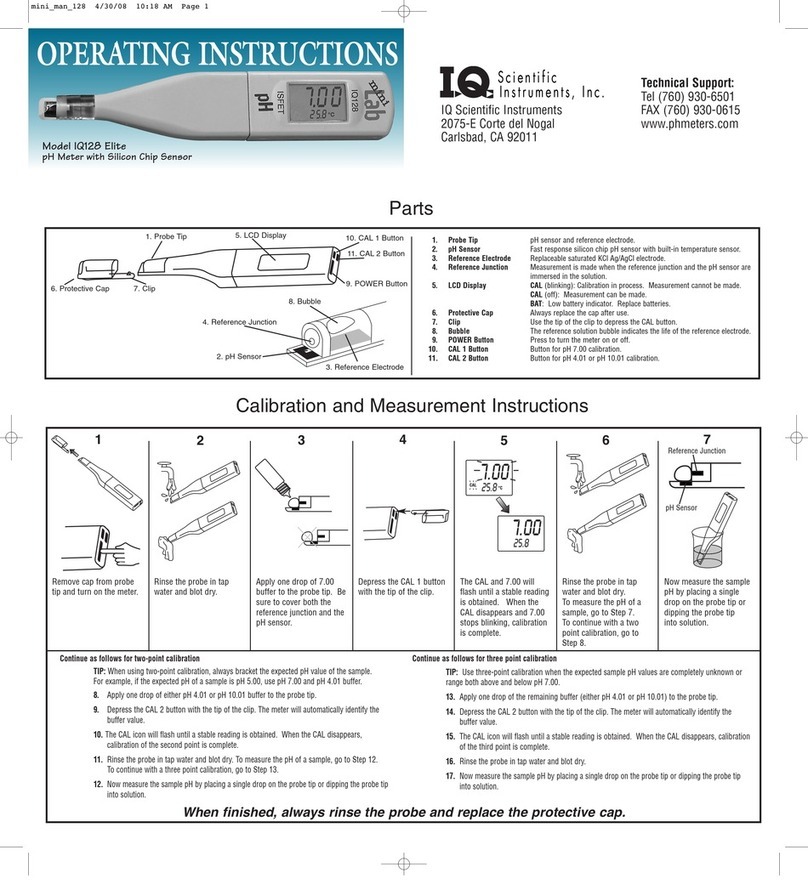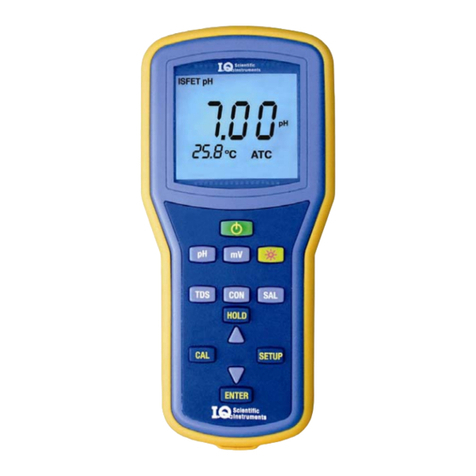
Table of Contents
Getting Started--
Quick Reference Guide for Two Point Calibration. . . . . . .
1
Techniques and Tips For Best Performance. . . . . . . . . . . . . . . . . . . . . . 4
Display Features and Meter Connections. . . . . . . . . . . . . . . . . . . . . . . . 6
Main Display. . . . . . . . . . . . . . . . . . . . . . . . . . . . . . . . . . . . . . . . . . . . 6
Meter Connections . . . . . . . . . . . . . . . . . . . . . . . . . . . . . . . . . . . . . . . 7
Status Indicators. . . . . . . . . . . . . . . . . . . . . . . . . . . . . . . . . . . . . . . . . 7
Keypad Functions. . . . . . . . . . . . . . . . . . . . . . . . . . . . . . . . . . . . . . . . 9
Cleaning and Reconditioning the Probe. . . . . . . . . . . . . . . . . . . . . . . . . 11
pH Calibration and Measurement . . . . . . . . . . . . . . . . . . . . . . . . . . . . . 13
Important Notes for Best Calibration Results. . . . . . . . . . . . . . . . . . . 13
Calibration With Two Buffers. . . . . . . . . . . . . . . . . . . . . . . . . . . . . . . 14
Calibration With Three Buffers . . . . . . . . . . . . . . . . . . . . . . . . . . . . . 15
Calibration With One Buffer. . . . . . . . . . . . . . . . . . . . . . . . . . . . . . . . 16
How to AbortCalibration. . . . . . . . . . . . . . . . . . . . . . . . . . . . . . . . . . 16
Automatic Buffer Recognition. . . . . . . . . . . . . . . . . . . . . . . . . . . . . . 16
Automatic Temperature Compensation of Automatic Buffer
Recognition Values. . . . . . . . . . . . . . . . . . . . . . . . . . . . . . . . . . . . . . .
17
Changing Stored Automatic Buffer Recognition Values. . . . . . . . . . 17
Restoring Automatic Buffer Recognition Values to Factory Default. 18
mV Measurement . . . . . . . . . . . . . . . . . . . . . . . . . . . . . . . . . . . . . . . . . . 18
Titrations . . . . . . . . . . . . . . . . . . . . . . . . . . . . . . . . . . . . . . . . . . . . . . . . .
Storing and Recalling Data. . . . . . . . . . . . . . . . . . . . . . . . . . . . . . . . . . . 19
20
Storing Sample Readings. . . . . . . . . . . . . . . . . . . . . . . . . . . . . . . . . . 20
Recalling Sample Readings . . . . . . . . . . . . . . . . . . . . . . . . . . . . . . . . 20
Clearing Data from One Storage Address. . . . . . . . . . . . . . . . . . . . . . 21
Clearing Data from All Storage Addresses. . . . . . . . . . . . . . . . . . . . . 21
Output Modes . . . . . . . . . . . . . . . . . . . . . . . . . . . . . . . . . . . . . . . . . . . . . 22
AnalogOutput. . . . . . . . . . . . . . . . . . . . . . . . . . . . . . . . . . . . . . . . . . . 22
Serial Output. . . . . . . . . . . . . . . . . . . . . . . . . . . . . . . . . . . . . . . . . . . . 22
Output of Calibration Data to the Serial Port. . . . . . . . . . . . . . . . . . . 23
Output of Current Sample to the Serial Port. . . . . . . . . . . . . . . . . . . . 23
Output of the Contents of a Single Memory Address . . . . . . . . . . . . 23
Output of the Contents of all Memory Addresses . . . . . . . . . . . . . . . 23
Setting the Baud Rate. . . . . . . . . . . . . . . . . . . . . . . . . . . . . . . . . . . . . 23
Temperature Calibration . . . . . . . . . . . . . . . . . . . . . . . . . . . . . . . . . . . . 24
User Temperature Calibration. . . . . . . . . . . . . . . . . . . . . . . . . . . . . . . 24
Restoring Temperature Calibration to Factory Default. . . . . . . . . . . 24
Battery Replacement. . . . . . . . . . . . . . . . . . . . . . . . . . . . . . . . . . . . . . . . 25
Troubleshooting. . . . . . . . . . . . . . . . . . . . . . . . . . . . . . . . . . . . . . . . . . . . 26
Error Codes. . . . . . . . . . . . . . . . . . . . . . . . . . . . . . . . . . . . . . . . . . . . . . . 27





























